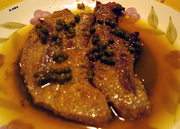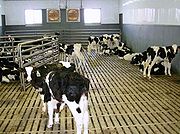Veal
Veal is the meat of calves (young cattle). Though veal can be produced from any calf, most veal comes from male calves of dairy cattle breeds. Compared to other meats, veal has a delicate taste and tender texture.
Contents |
Types
There are four types of veal:
- Bob Veal, from calves that are culled a few days after birth when they weigh 150 lb. (USA only)[1]
- Formula-Fed (or "milk-fed") veal, from calves that are raised on a nutritionally complete milk formula supplement. The meat colour is ivory or creamy pink, with a firm, fine and velvety appearance. Usually marketed as veal when they reach 18-20 weeks of age (450-500 lb). [2]
- Non-Formula-Fed ("red" or "grain-fed") [3] veal, from calves that are raised on grain, hay or other solid food in addition to milk. The meat is darker in colour, and some additional marbling and fat may be apparent. Usually marketed as calf rather than veal at 22-26 weeks of age (650-700 lb).
- Rosé Veal UK is from calves reared on farms in association with the UK RSPCA's stringent Freedom Foods programme. Its name comes from its pink colour, which is a result of the calves being culled at around 35 weeks. [4]

Veal is often compared to beef but is lighter in colour and finer in texture and veal usually comes from a (male) dairy calf.[5]
The veal industry's support for the dairy industry goes beyond the purchase of surplus calves. It also buys large amounts of milk by-products. Almost 70% of veal feeds (by weight) are milk products. Most popular are whey and whey protein concentrate (WPC) by-products of the manufacture of cheese. Milk by-products are sources of protein and lactose. Skimmed milk powder, casein, buttermilk powder and other forms of milk by-products are used from time to time. [6]
Culinary uses

Veal has been an important ingredient in Italian and French cuisine since ancient times. The veal is often in the form of cutlets, such as the Italian cotoletta or the famous Austrian dish wiener schnitzel. As veal is lower in fat than many meats, care must be taken in preparation to ensure that it does not become tough.
In addition to providing meat, the bones of calves are used to make a stock that forms the base for sauces and soups such as demi-glace. The stomachs are also used to produce rennet, used in the production of cheese.
Production
Before the 1960s, milk-fed veal was raised primarily by the dairy farmer as a method of gaining some economic advantage from the many bull calves born each year that were not required for breeding. Eventually, the farmer found that raising this young animal and meeting the specific needs of the calf proved challenging in the midst of the mature cattle members of his herd.
Early producers found that a separate micro-climate was the only means of raising a calf through the perils of early growth. The growing stall was thus born. In the beginning these separated growing areas were almost totally enclosed. This was thought to curtail the spread of disease and provide a clean and comfortable environment in which the calf could flourish. Mortality was reduced substantially and product quality and quantity improved. As time and management philosophy developed the stall was changed. It became larger and more open. The stall also provided an opportunity for individual handling of the calf. However, many animal welfare activists oppose the use of these crates. Veal crates were banned in the UK (under the 1987 "Welfare of Calves Regulations" which came into effect in 1990)[7] and throughout the European Union in 2007.
There has been some controversy in veal-raising methods over the years, including housing, use of antibiotics and hormones. In Europe, these issues have all been addressed. In North America, there has been a general lag in these areas but there is no use of hormones now and use of antibiotics follows withdrawal guidelines. This is actively monitored by government agencies. The AVA (American Veal Association) announced in 2007 a 10 year phasing out of "crates".[8] California will have a ballot initiative, Proposition 2 (Prevention of Farm Animal Cruelty Act) on the November 2008 ballot which would ban veal crates as well as sow gestation crates and severe confinement of egg-laying hens.[9] The tethering of calves in the USA was mostly due to economics as the cost of housing is reduced. This made veal raising viable for a family farming operation.
In North America, there has been a recent move to more group housing, although it has been used since 1981 in various forms.
Housing
There are primarily three different types of housing used for veal calves: hutches, stalls, or various types of group housing. [10]
Hutches

- Calves are kept in isolation from other calves when they are young and vulnerable to infectious disease.
- Calves are moved to a group setting in a few weeks when they are stronger and less likely to succumb to disease.
- Hutches provide shelter from extremes in temperature and wind, and are usually bedded with straw.
- Water is available at all times and the calves are fed two or three times a day with a milk replacer and grain mix.
Stalls

- Calves cannot move around.
- Feed intake can be monitored and adjusted on an individual basis.
- Individual attention can be paid to each calf and the stall itself provides protection for weaker calves against bullying.
- The amount of feed consumed provides an indication of the health of the calf as reduced intake is often one of the first signs of sickness.
- The feeding area is not able to be contaminated by other calves.
Group Housing

- Calves can move around freely.
- Calves have rest areas available to them.
- Feed intake can be monitored and controlled by use of an electronic tag.
Open straw yards
- A variant of group housing with straw bedding.
- Calves have access to more roughage, contributing to the redder colour of rosé veal.
- Mostly assoiciated with organic meat industry in an effort to maximize animal welfare.
Feeding
Milk-fed veal calves consume a diet consisting of milk replacer, formulated with mostly milk-based proteins with added vitamins and minerals to provide a balanced nutritional solution. Calves have access to water and often to roughage such as coarse grains.
Grain-fed calves normally consume a diet of milk replacer for the first 6-8 weeks. They also have access to water and roughage such as hay during this time. The calves then move on to a corn-based grain feed.
Animal welfare
Veal is still a controversial issue in terms of animal welfare.[11] There is adequate scientific evidence available to support complaints that despite careful management a significant proportion of "special-fed" calves will inevitably experience health problems including pneumonia,[12][13] clinical anemia,[14] and stomach ulcers.[15]
Refinements such as group housing[16] begin to address some complaints about veal raising such as the use of small stalls in which animals cannot socialize normally, and in some countries, such as the UK, stalls have been banned mainly due to the lack of animal welfare associated with the rearing procedure.[17][18] In addition to not allowing calves to socialize normally, stalls prevent calves from being able to move. Though this method provides for tender veal due to lack of muscle usage, it is considered by animal welfare advocates to be cruel. Many issues remain unresolved including practices relating to weaning, transportation, social grouping, feeding methods[19] and nutrition that continue to place stresses on calves that have demonstrably negative effects on their health and behavior.
Alternative agricultural practices for using male dairy calves include raising Bob veal (immediate slaughter), raising as "red veal" without the severity of dietary restrictions needed to create pale meat (resulting in fewer antibiotic treatments and fewer culled calves),[20] and as dairy beef.[21]
References
- ↑ Calves and antibiotic residues
- ↑ milk-fed veal definition
- ↑ Grain-Fed definition in Recommended Code of Practice for Raising Farm Animals
- ↑ The Appeal of Veal
- ↑ BBC Food - Food matters - Is veal cruel?
- ↑ Veal could be sold from the dairy case -Delft Blue
- ↑ Barclay,C. (2000). Research paper 00/11. The Export of Farm Animals Bill. House of Commons, London. [1].
- ↑ Statement on American Veal Association's Veal Crate Announcement
- ↑ Californians for Humane Farms
- ↑ Learning more about Veal Calf housing
- ↑ Rollin E. Farm Animal Welfare: Social, Bioethical, and Research Issues. Ames: Iowa State Press. 1995.
- ↑ McFarlane JM, Morris, GL, Curtis, SE, et al. Some indicators of welfare of crated veal calves on three dietary iron regimens. J Anim Sci 1988;66:317-325
- ↑ Sargeant JM, Blackwell TE, Martin W, et al. Production practices, calf health and mortality on six white veal farms in Ontario. Can J Vet Res 1994;58:180-195.
- ↑ Stull CL, McDonough SP. Multidisciplinary approach to evaluating welfare of veal calves in commercial facilities. J Anim Sci 1994;72:2518-2524.
- ↑ Welchmen DD, Baust GN. A survey of abomasal ulceration in veal calves. Vet Rec 1987;121:586-590
- ↑ Veal association recommends group housing - September 15, 2007
- ↑ Friend TH, Dellmeier GR, Gbur EE. Comparison of four methods of calf confinement. I, physiology. J Anim Sci 1985;60:1095-1101.
- ↑ Dellmeier GR, Friend TH, Gbur EE. Comparison of four methods of calf confinement. II. Behavior. J An Sci 1985;60:11-2-1109
- ↑ Ahmed AF, Constable PD, Misk NA. Effect of feeding frequency and route of administration on abomasal luminal pH in dairy calves fed milk replacer. J Dairy Sc 2002;85:1502-1508.
- ↑ Sargeant JM, Blackwell TE, Martin W, et al. Production indices, calf health and mortality on seven red veal farms in Ontario. Can J Vet Res 1994;58:196-201.
- ↑ Maas J, Robinson PH. Preparing Holstein steer calves for the feedlot. Vet Clin Food Anim 2007;23:269-279
External links
- Frequently Asked Questions of the American Veal Farming Industry.
- Ontario Veal Association — Ontario Veal Industry in Canada.
- The Economic Consequences of Adopting Alternative Production Systems to Veal Crates — The cost of abandoning veal crates, from the Humane Society of the United States.
- Thinking Outside the Box — Dutch veal farming from Beef magazine.
- Veal Farm — Veal Industry in the USA.
- Veal Information Gateway — Veal calf raising and veal recipes.
- Veal Recipes.